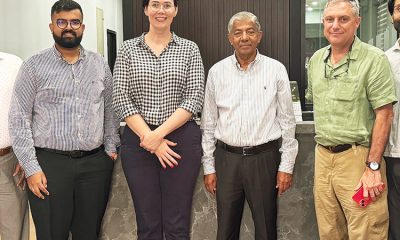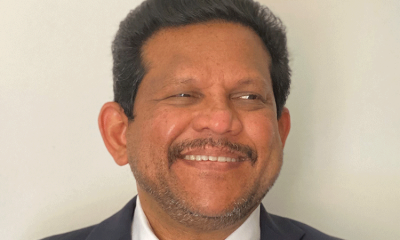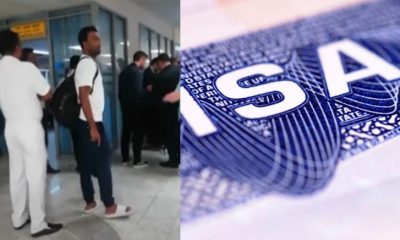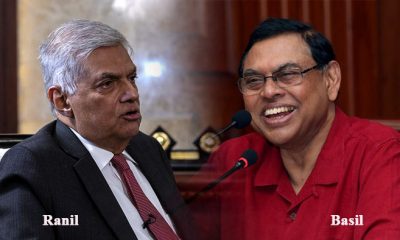Midweek Review
Up the garden path with the JVP. Again?

by G. B. Morrel
In 1970-71, when I was enrolled at Maharagama Teachers’ College, the JVP, better known then as Che Guevarists, were active there, most noticeably in the hand-written posters they plastered on the parapet wall at the entrance. But we English trainees, the “kaduwa” group, had little interest in revolutionary politics.
Then, in April ’71, the JVP launched the insurgency. The college was closed for the April holidays. Amateurish and poorly organised, the insurgency was crushed within a few weeks.
I received a telegram from the principal, asking me to report to him ASAP. When I did, a police jeep took me to the Maharagama police station for questioning. My crime? Playing cricket. Apparently, the team’s opening bowler was a JVP leader, and I had dropped-in at his “chummery” on the way to practice.
The police station had been attacked by teacher trainees on April 5, and three captured trainees were lying in the remand cell, beaten-up and whimpering in pain. Despite the repeated yells from the HQI next door to “give him (me!) the works”, the kindly sergeant who questioned me realised that this terrified “lansiya” had no terrorist motives, and I was allowed to go home that evening. But others weren’t that fortunate. When the teachers’ college reopened, the more active Che Guevarists were not to be seen. Taken up the garden path by the JVP, and duped into an illusion of taking over a country with old shotguns and crude hand bombs, they had vanished into prisons or unmarked graves.
I begin with this personal anecdote because, over the past 50 years, I have observed the JVP leading the people of this country astray, while committing atrocities that have brutalised our society. This is not a lengthy, analytical dissertation on the duplicity of the JVP, but a brief attempt to revive readers’ memories and warn of coming danger.
Intimidating higher education
My next encounter with the JVP was at Kelaniya Campus, where I taught as an instructor later in the 70’s. The students’ council was in the hands of the JVP by then, and, mainly through intimidation, they ran the campus. New students were ragged mercilessly, and staff members who opposed the ragging threatened. Once, passing the Vice Chancellor’s office, I saw that it was crowded with JVP goons, some even standing on his desk and shouting at the VC, who was seated, obviously terrified. A grandfatherly professor, he was no match for the thugs.
I also recall some young mathematics teachers who were admitted to campus for a diploma course. These teachers were dragged to the dark basement of the science faculty and brutalised (ragging is too polite a word for the violence that was enacted).
Due to strikes and violence, the campuses was shut down for months; I stayed home so often that neighbours assumed I was unemployed. Because of the postponements in the academic calendar, by as much as four years, some students preferred to go abroad for higher studies. Once bitten, many of them never returned to Sri Lanka, depriving the country of their talent and potential contribution.
Another short-sighted JVP move was against the North Colombo Medical College (NCMC), a fee-levying, non-profit institution that was set up by the College of General Practitioners. The JVP led a non-stop campaign against the college, culminating in a bomb attack in 1988. The college had graduated more than a thousand doctors by then. It was nationalised the following year.
Privately funded higher education was unknown in South Asia at that time, and had the college continued, it would have attracted international students from the region, bringing foreign exchange into the country, and leading to the creation of a high-quality medical hub, including world class medical schools and teaching hospitals. Instead, now, millions of dollars leave the country each year as fees by Sri Lankan students enrolled in foreign medical schools.
Years later, I came to know Dr. Sathis Jayasinghe, who was a founding member of the NCMC. Gentle and soft-spoken, a beloved family physician, he was called the “visionary who created 1,000 doctors” when he passed away last year. Had the college been allowed to continue, Dr. Jayasinghe would have created 10,000 doctors, saved Sri Lanka millions of dollars, earned foreign exchange, while providing world class medical care to everyone.
The insurrection
More Sri Lankans may have experienced the JVP’s second violent attempt at seizing power in 1987-89. Better organised than the 1971 insurgency, the JVP resorted to “subversion, assassinations, raids, and attacks on military and civilian targets”. Not only were the police and security forces attacked, but even their families were not spared.
In essence, the JVP was being opportunistic, assuming that the government would not cope with two conflicts, in the north and east with the LTTE and with the JVP elsewhere. But they were proved wrong, instead forced to drown in a bloody retaliation that the government unleashed. For a moment, assuming that the JVP was victorious, how could they have fought the LTTE? With the help of their erstwhile friends, the North Koreans?
Two of the JVP killings still rankle me. One is the assassination of Vijaya Kumaratunga, who brought a sense of idealism from his heroic cinema roles into politics. The second was the killing of Premakeerthi de Alwis, who brought so much joy to music lovers like me with his lyrics describing the bitter sweetness of youthful love. Called “a lyric writing machine” by his first wife, Premakeerthi wrote hundreds of songs for numerous artistes, and would still be writing memorable lyrics if he had been allowed to live.
What was achieved by killing Vijaya and Premakeerthi?
Making heroes out of murderers
Every year, the JVP holds a commemoration for “fallen comrades”. At this and other occasions, their founding leader is portrayed with a beret at a rakish angle and a beard, symbolic of Che Guevara and Castro. But the Che that they idolise succeeded only in Cuba. His attempts to foment rebellion in Africa and South America went nowhere. Likewise, Castro’s flawed policy – allowing Soviet ballistic missiles on Cuban soil, only 90 miles from the USA – lead to strict sanctions by the US that have impoverished Cuba ever since. I do not condone the sanctions, but what did Castro expect to achieve by confronting the US?
Wijeweera, and other leaders of his era, have blood on their hands. While they are romanticised as heroes, no collective commemoration of JVP victims is held. Instead, their families mourn these victims in private grief.
At least two mainstream Sinhala newspapers have been carrying those beret clad photos of Wijeweera, and, on a regular basis, describing the 1971 insurgency, even those pathetic, starving retreats through jungles, in romanticised, nostalgic terms. Mythmaking at its best, and fodder for the gullible.
India as the ogre; Lessons not learned
 Having been in politics for more than 50 years, and with two crushing defeats under their belts, one would expect the JVP to learn some lessons. But, going by recent statements by Sunil Handunetti, a JVP leader, it seems otherwise.
Having been in politics for more than 50 years, and with two crushing defeats under their belts, one would expect the JVP to learn some lessons. But, going by recent statements by Sunil Handunetti, a JVP leader, it seems otherwise.
One topic of the JVP’s infamous five lectures was India’s expansionist agenda. In essence, the JVP was virulently anti-Indian. In a recent statement, Handunetti appears to echo the past, when he criticised the leasing of some oil tanks in Trincomalee to an Indian company, and a proposed bridge to connect India with Sri Lanka.
Those oil tanks were built before World War II, when Trincomalee, with its deep harbour, was developed as a logistics hub by the British. The 100 tanks, with a total capacity of 1.2 million tons, far exceeds Sri Lanka’s needs, and only 15 tanks are used by the Petroleum Corporation. Fifty tanks were leased recently to an Indian company, but the JVP sees this as a loss of sovereignty; instead of earning foreign exchange, allowing the tanks to rust and decay is their preference.
Anyone who has seen the desolation and the hard scrabble lives of Wanni residents would support any form of development in the region. The shutdown of the ferry service between the two countries dealt a blow to the little direct commerce that existed between the Mannar area and southern India. Talk of a bridge connecting India and Sri Lanka has been in the air for years. Such a link would be a boon to low impact tourism and commerce, and improve the wretched lives of many Wanni residents. Even if the bridge ever gets built, these Indians will not be coming as “kallothonis”. Instead, they will be arriving through formal immigration and customs regulations.
But, the JVP only sees swarms of Indians entering this country, threatening our so-called security and sovereignty. This type of thinking is known as “island mentality”, and harks back to the narrow-minded thinking of the “five lectures”. Of course, “threats from India” usually draw headlines and votes.
Ever since the race riots of 1958, and later fed by other acts of mass violence (the Black July of 1983 comes to mind), the JVP revolts, and the civil war, a large section of our society has no doubt turned brutish. The 2500-year civilization is no more than a myth, and Buddha’s teachings have been tarnished by politicised monks. Corruption, endemic to our society, has turned stratospheric since the “Helping Hambantota” scam. From the lowly peon at a government office to the highest offices of the land, not much gets done without a bribe.
Thus, the yearning for change in the country is understandable. For most people, a radical change of government – power going to a group that has not held power before – appears to be the obvious choice. Hence, the giddy enthusiasm for the JVP, and Anura Kumara Dissanayake being anointed the coming messiah. (Ironically, that’s how Gotabaya Rajapaksa was hailed before the last election.) But, with just 4% of the total vote at the last Presidential election, a snowball has a better chance in hell than a JVP victory at the next election. Nevertheless, there is another danger.
The Ralph Nader Effect
Nader is acclaimed for his activism in consumer protection, environmentalism, and government reform. Seat belts in vehicles, which have countless lives and major injuries, are attributed to his critique of American automobiles. But he has gained notoriety for a costly run for the Presidency of the United States.
The US Presidential election of 2000 came down to the wire, with the State of Florida deciding the ultimate winner. George W. Bush, the Republican candidate, won Florida by just 537 votes over the Democrat, Al Gore. Nader, running as the Green Party candidate, received 97,421 votes in Florida. Undoubtedly, Nader was a spoiler. The cost of Bush’s Presidency – to the Middle East, to Afghanistan – in the hundreds of thousands of lives lost, the massive displacement and destruction caused, the trillions of dollars gone to waste, is beyond question. So is the degradation of the environment.
When the next Presidential election comes around, if the percentage of the vote gained by the JVP is 10% or more, the SLPP (Pohottuwa) may squeeze out a win, a repetition of the Nader effect. The JVP will be the spoiler.
The JVP has much to its credit. It is perhaps the least corrupt, the least racist political party. It does not kowtow to monks. It has built up a solid following among the youth, but support from a broader section of the population, one that has experienced the 1971 insurgency and the 1987-89 insurrection, is lacking. An apology for those costly mistakes, and a renunciation of ardent nationalism, may bring them to the mainstream. But, as matters stand, the JVP is unlikely to compromise.
People my age bear the burden of memory of having seen firsthand the duplicity of and the destruction caused by the JVP. They have not changed their ways. Instead, a new crop of young men and women are being led up the garden path.
Human beings have notoriously short memories, and “those who ignore history are doomed to repeat it.”
Midweek Review
Solheim is back
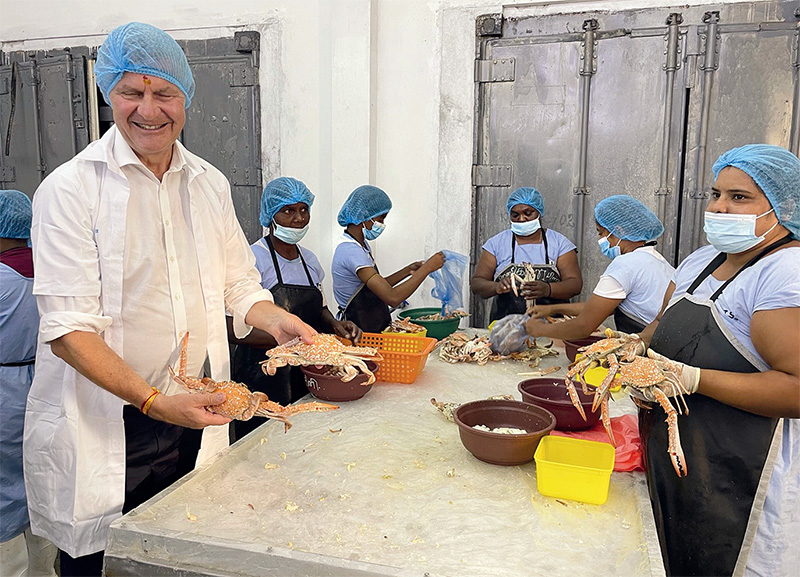
The Norwegians mollycoddled the LTTE. The way the government in Oslo went out of its way to appease the LTTE during the time it facilitated the peace process is unbelievable. Once a group of LTTE cadres visiting Norway was afforded an opportunity to see how the Norwegian military prepared for UN peacekeeping missions. Several weeks after the signing of the CFA in late Feb 2002, Balasingham and his Australian-born wife who had been pictured handing over cyanide capsules to female child soldiers arrived from London via Dubai and the Maldives to the Vanni in late March 2002. The Special Norwegian Peace Envoy Solheim and the then Norwegian Ambassador in Colombo Jon Westborg personally got involved in travel arrangements with Solheim accompanying the Balasingham’s from London to Dubai. It was quite a show.When Balasingham, a former Colombo British High Commission employee passed away in the UK in late Dec 2006, Solheim, in his capacity as the Norwegian International Development Minister was at Alexandra Palace in north London to pay his last respects. Balasingham departed the world three years before the Sri Lanka military eradicated the LTTE militarily in the battlefield itself.
Ex-SCOPP Chief on Solheim’s latest move
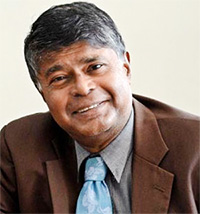 In response to The Island query, Prof. Rajiva Wijesinha, Secy General of SCOPP, sent us the following response: ” It was most entertaining to see Erik Solheim back in Sri Lanka, celebrating his dinner with his old friends Ranil and Maithree Wickremesinghe. Needless to say he reiterated what Mahinda Rajapaksa has been trumpeting, that Ranil did not run away when there was a crisis.
In response to The Island query, Prof. Rajiva Wijesinha, Secy General of SCOPP, sent us the following response: ” It was most entertaining to see Erik Solheim back in Sri Lanka, celebrating his dinner with his old friends Ranil and Maithree Wickremesinghe. Needless to say he reiterated what Mahinda Rajapaksa has been trumpeting, that Ranil did not run away when there was a crisis.
Of course Ranil did not run away, because he was prepared to swallow anything to revive his political career, even slavish adherence to the Rajapaksa forces, which confirmed him as Prime Minister under the President the country at large thought responsible for the crisis. These were not conditions anyone else could accept, though now they might regret that they did not know radical and not so radical forces would insist on the President going, and that his quondam hangers on realize that that would relieve the pressures on them and allow them to carry on as before.
Solheim, whose business instincts have always affected his political judgment, has not registered that the only improvement has been that the Sri Lankan government under Ranil has been able to borrow more money so as to pay for fuel, which is why that is available and power cuts have stopped. But when he says businesses were on the verge of collapse, he does not note that many businesses have indeed now collapsed, and that there have been no measures to improve productivity, not understanding that the only justification for more and more loans is to generate economic activity, not just more debt.
He claims inflation is low, but does not note how food prices rose so high that malnutrition has increased, and there is no effort to reduce this, instead the government is concentrating on selling off even profitable government undertakings. Ironically he ends his apology for an analysis with a Mahinda Rajapaksa catchphrase, doubtless now Ranil’s too, about a better future.
And then, to underline his point, after praising Ranil he also praises the dinner he enjoyed. It would be nice to know what he and his opulent globe trotting hosts ate, and how this compares with what most people have now to eat.”
By Shamindra Ferdinando
Attorney-at-Law Ambika Satkunanathan responded angrily on ‘X’ on May Day to a recent declaration made by former Norwegian International Development Minister Erik Solheim and top peace (or planned pieces) facilitator here during Chandrika Bandaranaike Kumaratunga’s tenure as the President that ‘Northern Sri Lanka is at peace.’
Solheim also commended the security situation in the northern region on ‘X’ posted on May Day following a recent visit to Jaffna and Kilinochchi where he met Northern Governor P.S.M. Charles and Illankai Thamil Arasu Kadchi (ITAK) leader Sritharan Sivagnanam.
Jaffna District parliamentarian Sivagnanam received appointment as the ITAK leader in late January this year. He comfortably defeated M.A. Sumanthiran PC in an internal party election. Sivagnanam succeeded Mavai Senathiraja.
Former Human Rights Commission member (Oct 2015-2019) Satkunanathan contradicted Solheim’s assertion.
She alleged that the Northern Province continued to be heavily militarized with security agencies carrying out surveillance, harassing and intimidating civil society and generally targeting those who defied the government. She claimed the targeted group included the media as well.
The Northern Province consists of the electoral districts of Jaffna and Vanni. The former LTTE stronghold Vanni comprises administrative districts of Mannar, Mullaithivu and Vavuniya. The last phase of combined security forces operations had been conducted in the Mullaithivu district where the war was brought to an end on the banks of the Nanthikadal lagoon in May 2009.
LTTE leader Velupillai Prabhakaran’s body was recovered from there on the morning of May 19, 2009.
Obviously Solheim, 69, was comparing the situation in the Northern Province during the war and now. Those who believed in the LTTE’s military invincibility were shocked and surprised when the Army brought back the Tiger stronghold Kilinochchi under government control in early January 2009 following two years of sustained operations in the eastern and northern theatres. The rest is history.
So-called human rights activist Satkunanathan reacted to only a section of Solheim’s statement. In fact, it was one of the three statements made by the Norwegian during his recent visit.
Satkunanathan faulted Solheim for praising the security situation in the Northern Province. One should understand Satkunanathan, with obvious Eelam sympathies, for being critical of Solheim, who now functions as Wickremesinghe’s International Advisor on Climate Change, and no longer towing the wholesale tilted line to their cause.
It would be better if key points in that statement were mentioned: (a) He visited Jaffna after a lapse of over 20 years (b) Many of his Sinhala and Tamil friends and colleagues were killed (c) delighted to discuss political developments with Sivagnanam whom the Norwegian described as the new top Tamil leader (d) Northern Province peaceful and no one wants to return to the situation experienced during the war (e) Many Tamil aspirations haven’t been fulfilled (f) wartime disappearances remain a major cause for concern (g) Some land taken over by the government/military during the war yet to be returned (h) disputes continue over historic religious sites (i) unemployment in the Northern Province remains an issue (j) Sri Lanka will have to devolve power (emphasis mine) and finally (k) struggle for Tamil rights would continue through non-violent means.
The second Solheim statement was headlined ‘The man who didn’t run away’. The Norwegian was referring to President Ranil Wickremesinghe, the leader of the UNP.
Solheim declared: (a) President Wickremesinghe pulled off a political miracle after the people ousted Gotabaya Rajapaksa over mounting economic crisis (b) Difficulties remain though further improvements can be expected (c) Wickremesinghe accepted the daunting challenge regardless of consequences. That statement, according to Solheim, was issued after he had a delicious dinner with his old friends President Wickremesinghe and first lady Maithriee Wickremesinghe.
Solheim received the appointment as Wickremesinghe’s Advisor on Climate Change within weeks after Parliament voted to have him as the eighth Executive President to complete the remainder of ousted Gotabaya Rajapaksa’s five-year term. Soon after receiving the appointment, Solheim declared that going green and finding a solution through the 13th Amendment to the Constitution could help Sri Lanka recover from its economic and political crisis.
There had been a third statement that dealt with Solheim’s visits to Taprobane Seafoods (Pvt) Ltd. production facilities in Jaffna and Mannar. Solheim, in a May 03 message on X, noted how Tamil women, who lost their husbands and other members of their families, benefited from the Taprobane factories. Solheim should be reminded of the mindless death and destruction caused by Tamil women who fought for the LTTE, including suicide cadres. The Norwegian has also forgotten how thousands of children, both male and female, who had been forcibly recruited by the LTTE, were used as cannon fodder.
The entire world realized the despicable use of children when a brainwashed LTTE female teenage suicide cadre blew up former Indian Prime Minister Rajiv Gandhi on May 21, 1991, as he campaigned, in Southern India, in the run up to the Indian general election.
Let me discuss Solheim’s assertions (both commendations and concerns) in the current context, also taking into consideration the Norwegian peace mission here.
Solheim on 13 A
The Norwegian’s declaration that Sri Lanka would have to devolve power in terms of the 13th Amendment to the Constitution that has been forced on Sri Lanka, by India, underscores the continuing Norwegian stand on the contentious issue. The decision on the part of President Wickremesinhe’s Advisor on Climate Change to discuss devolution of power, political developments and other related matters, including the security situation, cannot be acceptable. Solheim’s declaration that the Tamil struggle would continue through non-violent means must receive the attention of political parties represented in Parliament.
Perhaps, Solheim has to be told to stick to the subject Climate Change assigned to him by President Wickremesinghe instead of seeking to revive a needless bloody conflict here once again and especially reminded that the ITAK recognized the bloodthirsty LTTE as the sole representative of the Tamil speaking people during the time Norway facilitated the highly questionable peace process here and that tag of ‘sole representative’ remained until the military eradicated the Tiger terrorism from here. There is no doubt Solheim was one of those ill-advised diplomats or a deliberate hatchet man, who repeated their mantra that the LTTE couldn’t be militarily defeated. A section of the media, too, propagated the lie that the LTTE tactics were far superior to that of the military and whatever the territorial gains made by the military on the Vanni front could be undone.
The very basis of the Norway arranged Ceasefire Agreement was that the LTTE couldn’t be defeated. Therefore, a negotiated settlement has to be finalized even at the expense of the country’s national interest as the LTTE exercised undefeatable conventional military capability. Solheim was one of the crowd who regularly tried to drum into us that the LTTE could swiftly and decisively overwhelm the military on the Vanni east front. The eradication of the LTTE leader and his bodyguards on the banks of the Nanthikadal lagoon must have come as quite a shock to Solheim, who was one of the few foreign diplomats given access to Velupillai Prabhakaran.
However, at the time Solheim spearheaded the Norwegian effort, Norway openly asserted that the 13th Amendment was insufficient. With the backing of the ITAK, the LTTE demanded ISGA (Interim Self Governing Authority) pending finalization of a negotiated settlement but today interested parties quite conveniently have forgotten how the LTTE quit the CFA in late April 2003. That move was meant to sabotage peace negotiations and create an environment for the then President Kumaratunga to sack the UNP-led government. As the LTTE anticipated, the SLFP-led UPFA won the general election and in the following year the internationally proscribed group ensured Mahinda Rajapaksa’s victory at the presidential poll by depriving Ranil Wickremesinghe of the northern vote. The LTTE set the stage for Eelam War IV thinking it would be a cakewalk for them against a government led by Mahinda Rajapaksa. But Rajapaksa was made of much sterner stuff as he has proved from his school days.
The civil society remained silent as the LTTE resumed mine attacks in the Northern Province in Dec 2005 and in the following month blew up the Shaldag class Fast Attack Craft (FAC) off Trincomalee. The Mavilaru dispute erupted a few months later and war was inevitable. Between destruction of the FAC and Mavilaru confrontation, the LTTE made an abortive bid to assassinate the then Lt. General Sarath Fonseka, Commander of the Army. Soon after Eelam War IV erupted, the LTTE made an attempt on the life of Defence Secretary Gotabaya Rajapaksa. Had the LTTE succeeded in eliminating Lt. Gen. Fonseka and Gotabaya Rajapaksa, most probably, they could have had an opportunity to overwhelm the government. But, their strategy went awry in the wake of unsuccessful suicide missions. Both having miraculously survived the deadly attacks prosecuted the war with new vigour against the Tigers.
Norwegian tendency to go with the LTTE was revealed when Velupillai Prabhakaran assassinated the then Foreign Minister Lakshman Kadirgamar in early Aug 2005. The then Norwegian Foreign Minister Jan Petersen declared that: “The killing puts the peace process to a serious threat. It is now of great importance that both parties to the conflict do their utmost to fully fulfil their obligations according to the CFA.” That statement was in line with the stand taken by the Western powers and India that the assassination of Kadirgamar shouldn’t in any way hinder the so-called peace process. They also demanded the implementation of Post-Tsunami Operational Management Structure (P-TOMS). The UN Security Council, under Japanese leadership, insisted on the implementation of the CFA.
If the LTTE hadn’t declared all-out war in August 2005 and ultimately succumbed to relentless military onslaught, it could have had control of the Northern and Eastern Provinces with the backing of Western powers.
The writer sought the Executive Director of National Peace Council (NPC) Jehan Perera’s response to Solheim’s latest intervention. The ever obliging Dr. Perera sent us the following statement and is reproduced verbatim without any alterations. “Mr Solheim is reflecting the fact that more needs to be done. He sees Jaffna as being a better place than it was during the war. He tried to bring that war to an end through the ceasefire agreement of 2002 in which he and the President were two key architects. The affection and admiration that Solheim feels for the President is evident in what he says. He also poses a challenge to the President when says that much remains to be done. The question is whether the President can take up this challenge in the spirit of what needs to be done — and create trust in the Tamil community, an enabling environment for what needs to be done and develop a holistic plan for the future with multi-party engagement and consultation.”
Architect of CFA
Among those who met Solheim during his recently concluded visit were SLPP MP and its National Organizer Namal Rajapaksa and Basil Rajapaksa. What has Presidential Advisor on Climate Change got to do with the Rajapaksas? What the Norwegian had to discuss is unclear as he, too, obviously believed the Rajapaksas caused the war and were responsible for the death and destruction.
During a discussion the writer had with the late Kumar Rupesinghe at his residence in Colombo, the prominent civil society activist named Solheim as the person who actually drafted the CFA. When the writer doubted Rupesinghe assertion that if not for Solheim, the 2002 CFA couldn’t have been finalized, he offered me a copy of ‘Negotiating Peace in Sri Lanka: Efforts, Failures and Lessons (Volume Two) edited by him.
There were interviews with and articles by Bradman Weerakoon, Austin Fernando, Prof. G.L. Peiris, Priyan Seneviratne and Dinidu Endaragalle, Hagrup Haukland, Dharmnaratnam Sivaram, Gayathri Wickramasinghe, Saman Kelegama, Sunil Bastian, Sumanasiri Liyanage, Bernard A.B. Goonatilleke, M.I.M. Mohideen, Erik Solheim, Keith Noyahr and N. Ram.
In response to a query posed by Rupesinghe, Solheim, in his capacity as International Development Minister, has explained the circumstances under which the CFA subsequently called a flawed document by Lakshman Kadirgamar was finalized.
Solheim disclosed how he had discussed the provisions of the proposed CFA agreement with the LTTE theoretician in London, the late Anton Balasingham, and Prof. Peiris and Milinda Moragoda (both members of the government negotiating team) in Colombo before he drafted a new proposal. Let me reproduce the relevant section verbatim. The interviewer Rupesinghe quoted Solheim as having said: “…. The two parties made a lot of changes and brought it back to us and it was discussed orally. Then again I drafted a new proposal, which took about two months. It was signed on the 22nd of February. A period of 6-8 weeks was spent on discussions and writing the agreement.”
That interview certainly explained Solheim’s thinking and how he spearheaded the Sri Lanka mission on the invitation of the LTTE. Solheim discussed their role here against the backdrop of Norwegian involvement in similar endeavours following the end of the Cold War, especially in Palestine.
Solheim briefly discussed the Norwegian mission in Sudan and the Israel-Palestine deal which he called the most famous out of various peace projects.
At the time the LTTE reached Solheim; he had been a member of the Foreign Policy Committee of Norwegian Parliament and was in touch with various parties involved in the Sri Lanka conflict, having first visited Colombo in 1999. By then, the LTTE had been in a commanding position in the North but the group sought internationally guaranteed agreement to allow evacuation of Anton Balasingham, who needed urgent medical attention overseas. Though the initiative inspired by the LTTE failed to materialize, the LTTE got Balasingham out of Sri Lanka through other means to ensure he received the required treatment in Thailand before being moved to Norway. The Balasinghams left the Vanni in late January 1999.
The CFA was meant to create a separate region under LTTE control in the Northern and Eastern Provinces. The Scandinavian truce monitoring mission simply did nothing to ensure the implementation of the CFA. Taking cover of the CFA, the LTTE brought in ship loads of arms though the Navy twice intercepted and destroyed LTTE vessels. The group expanded a network of runways for its fledgling air force in the Vanni as the government foolishly further strengthened the group. It facilitated the acquisition of powerful radio equipment while transfer of brand new double cabs were also allowed much to the dismay of the military. The LTTE always had its way until President Mahinda Rajapaksa decided to put an end to the separatist terrorism.
In the wake of Solheim’s declarations, New Delhi-based Norwegian Ambassador Mrs. May Elin Stener, also accredited to Sri Lanka, was here accompanied by Johan Bjerkem, the Second Secretary of the Norwegian Embassy. The Norwegian envoy’s visit here was the first since Norway closed its Embassy in Colombo following the Gotabaya Rajapaksa government pulling out the Lankan missing in Oslo.
Ambassador Stener met Opposition Leader Sajith Premadasa and JVP leader Anura Kumara Dissanayake among others. Norway seems interested in expanding its role as Sri Lanka prepares to go for presidential polls.
Midweek Review
System Change: Is Sri Lanka to become an Indian ‘Pradesh’?

By Chandre Dharmawardana
chandre.dharma@yahoo.ca
The Aragalaya came and went. The claim that “we need a system change in Sri Lanka” has become the main legacy of that upheaval that brought Sri Lanka to the cusp of a violent takeover by organised left-wing or right-wing groups. The call for a “system change” is nothing new. I remember how Mahinda Wijesekera, a JVP leader of the 1970s (who became a UNP minister) justified militant actions at the Vidyodaya campus (now SJP university) saying Raamuva Venaskireema ––”a change of frame”––was the main lesson of the campus. President Gotabhaya Rajapaksa’s non-confrontational approach may have fortunately averted bloodshed, but it delivered the country squarely into the hands of international Shylocks and their local financial and political agents.
President Ranil Wickremsinghe (RW) emerged as the perfect fit for the occasion, with immense administrative experience as a Prime Minister and minister many times over. RW’s libertarianism is “in sync” with the mindset of bankers in Washington and the dealers in Davos. RW may not be accountable to a public who had rejected him and his party unequivocally in 2020. By the same token, he can only be a caretaker President. However, the main demand of the public was that “ALL 225” parliamentarians must be sent home. The politicians, labeled as crooks, do not enjoy the trust of the public. Instead, RW has symbiotically protected even crooks to sustain his government, claiming the need for stability to “implement the recommendations of the IMF”.
However, a less publicised agenda for creating free trade zones familiar from the early days of Yahapalanaya seems to also exist.
The IMF’s position is simple – it will provide emergency money to Sri Lanka so that Sri Lanka can pay back its loans amounting to some fifty billion US dollars. The IMF’s priority is to protect the Shylocks while the borrower is brought down to pay up. Debt write-off is never on the table; in any case the outstanding lenders are NOT governments, be it China, Japan, India or even the USA. There is no Chinese debt trap or any other conspiracy trap except in the minds of some political spin doctors.
IMF loan or not, Sri Lankans have to cut down imports, live frugally, produce more, get rid of loss-making enterprises, and increase forex inflows. Given that most of Sri Lanka’s earnings are in the hands of a mere 1% of the population, the draconian impact of the IMF loan must also fall on this rich 1% via a wealth tax. New taxes have been levied heavily on local products, while sparing and encouraging imports that cost forex! Even issuing visas to incoming tourists is now done by a foreign company getting paid in forex. Local operators would have been paid in rupees.
Meanwhile, the raising of the wages of estate workers by decree, with little concern for the health of the estate sector, shows that RW would readily discard his avowed free-market ideology for short-term votes.
Nevertheless, everything on the table shows that the government, the Central Bank, and their economic advisors are following text-book free-market theories within the simplest of globalisation concepts that work for big nations with strong export economies. The proposition that a free flow of goods, services and talent, as well as the adhesion to a larger market leads to greater overall prosperity does hold in the long run. The free-trade agreements covering the European Union, or the USA, Canada and Mexico, and the failure of Brexit have shown this to be true. However, this prosperity benefits the bigger partners most, while the smaller partners have to accept the erosion of their own industries and start-ups in competing with those of the bigger partner, at least for a generation or two. Furthermore, a smaller country tying up with a behemoth may have to accept the waste products of the big brother, polluting industries and agree to provide cheap raw materials to profit from the trickle-down prosperity promised for the future. Canada and Mexico have played that subservient role for years in their “free trade” with the USA, and faced trade barriers in spite of agreed-upon “free trade”.
When Sri Lanka ties up with India, as seems to be the undeclared plan of the Ranil–Basil consensus, we can certainly expect and profit from the opening up of a much larger market for Sri Lankan goods. But has Lanka competitively priced goods to sell? We may expect a more stable supply of electricity and fuel when grid connectivity and pipeline connectivity with India are established. But then, as Germany found out with the dawn of the Ukraine war, its dependence on Russian oil exposed its vulnerability and lost sovereignty. Many of India’s neighbours, such as Sikkim and Nepal, found that they had become mere Indian dependencies through power lines and pipelines.
The change of the “system” to that of a Lanka-pradesh integrated even loosely with India, as well as the disbursement of business to Indian and international conglomerates will provide much “bakshee” to the politicians at the helm, while sacrificing a generation of indigenous entrepreneurs. This already happened under the first stint of the open-market under JRJ, but the wholesale takeover of business by Indian business could not happen then. However, given an overt or covert full free-trade agreement, Indian business will be able to bid at least on an equal footing, and in fact more clout than a local businessman. When a job is advertised, Indians can apply equally, and perhaps even find more favour with Indian companies.

A recent report of the Madras Courier states that some 93,000 candidates applied for 62 “peon” posts in Uttar Pradesh police department (https://madrascourier.com/policy/indias-unemployment-crisis/) ,which required a minimum eligibility of grade 5; however, there were 3,700 Ph.D holders and 28,000 post-graduates and many graduates. Once the “system changes, in Lanka Pradesh every Sri Lankan job opening can in principle profit from a vast pool of Indian candidates, with Sri Lankan applicants elbowed out.
The crushing youth unemployment in India belies the so-called economic miracle of Narendra Modi. The top 1% of Indian society now owns most of India’s wealth. The extreme rise in inequality in India under Modi is seen in the attached graph; the rich are getting richer, the poor are getting poorer, while the middle class is getting eliminated. Indian Elites have spread this claim of a vibrant and rapidly growing India in all sorts of fora including at the Oxford Union debates, while the reality is seen in scholarly reports of Indian and international research. The seeming prosperity of Modi’s India at the moment is not unlike the facade of prosperity that Sri Lanka had, under the Rajapaksas just after the end of the Eelam war.
Local apparatchiks of the RW–Basil consensus will benefit handsomely from the largess of Indian business as the latter establishes itself in Sri Lanka. The high-flying Adani Group, associated with Narendra Modi, has already positioned itself in ‘Lanka Pradesh’. The methods they use were documented in Hindenburg Research.com, 23rd January 2023 under the title “How the world’s third richest man is pulling the largest con in corporate history“. The Mannar wind turbine deal commits Sri Lanka to buying electricity from Adani at higher prices for many decades to come. How was this outrageous sellout to Adani signed? Was there an environmental impact assessment?
The Mannar wind farm is not only an economic sellout but also an environmental disaster, as detailed by the renowned biologist Rohan Pethiyagoda (https://www.youtube.com/watch?v=Nm5w2vMXgjI ). The importance of preserving bird migration patterns for insect control, cloud seeding, crop pollination, biodiversity etc., are unfortunately not at all appreciated by Sri Lanka’s ruling class or Adani and Modi. Unfortunately, even good science-based ecology has earned a bad reputation in Sri Lanka due to pseudo-science based environmental groups. These “environmental” NGOs, organic food vendors, Natha-Deyyo-arsenic cabals and others got Gotabhaya’s government to ban agrochemicals, created famine, triggered a farmer uprising, an aragalaya joined in, and made Gota Go Home
(https://www.realclearmarkets.com/articles/2023/01/05/the_us_must_learn_from_sri_lankas_green_policy_mistakes_873852.html).
The Indian continent and Sri Lanka have been separate geographic entities since the time of the last Ice Age some 10 centuries BCE. A unique biodiversity in Sri Lanka distinct from that of the continent evolved in Lanka. The physical separation has protected Sri Lanka from epidemics and infections that rage in insalubrious India. A land bridge and such links connecting Sri Lanka with India will completely upset the existing bio-ecosystem and inflame ethnic-identity politics. I had written about this (Island newspaper: 19th July 2015 ) when the then Yahapalanaya government proposed a land bridge to India.
To give just one example, the early work of Philips (1935) on Lankan mammals has been handsomely updated by Asoka Yapa and Ratnavira in their monumental ‘The mammals of Sri Lanka’ (2013). The 50 km separation of India has given the Island 126 species of mammals, and no other island of comparable size is as diverse, with 1/5 of this diversity endemic to Lanka! Since local politicians (“Vavullu”) cross easily from side to side, Sri Lanka even has over 15 species of bats. The diversity of plants specific to Sri Lanka can be discerned from the web pages dh-web,org/place.names/bot2sinhala.html.
What is true for biodiversity is also true for cultural diversity. The Hinduism of Jaffna relates to the early monistic form of the “Saiva Siddhanatha” due to saint Thirumular. In contrast, Tamil-Nadu Saivism is pluralistic and follows Aghorasiva, who rejected the “monism” of Thirumular. Given a land bridge, the more profitable northern Kovils will pass into Indian hands. The Saivism offered will become the Saiva Siddhanatha of Aghorasiva. While Sinhala and Tamil cultures co-existed within Lanka until the advent of Chelvanayagams “exclusive Tamil homelands” doctrine, any free access to the tycoons of Tamil Nadu will erode the identity of Lankan-Tamil and Sinhalese Cultures as well. The latter, used to centuries of such interactions may survive the challenge of a land bridge, while Lankan Tamil culture will be stifled by the embrace of Tamil Nadu.
All this does not mean that a free-trade zone with India should not be an objective for Sri Lanka. However, this has to be done from a position of economic strength and not when fire-sale conditions of disaster capitalism exist in the country. The first objective must be to achieve energy and food self sufficiency – perfectly achievable, as outlined by me in previous articles (e.g., Island article 12th August 2021). Then only should the nation seek unbridled international free-trade links.
Midweek Review
First in the Firing Line
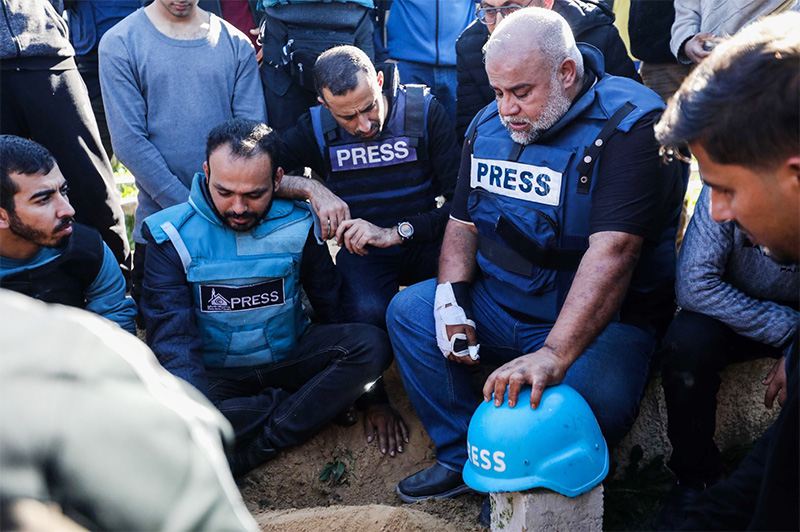
By Lynn Ockersz
Let all the world bow low,
To journalists being targeted,
Tragically felled and silenced,
By the mighty the world over,
In orgies of blood-letting,
Merely for reporting the truth,
Writing ‘the First Draft of History’,
And putting the record straight,
Long before the pundits do,
For, if not for these brave spirits,
Ignorance would rule the world,
And Power would do all the talking.
-

 Features6 days ago
Features6 days agoSearching for Dayan Jayatilleka
-

 News6 days ago
News6 days agoBIA thrown into turmoil as foreign firm handles on-arrival visa counter
-

 News4 days ago
News4 days agoLankan wins UK’s prestigious hair and beauty awards 2024
-

 Business4 days ago
Business4 days agoUSDA Under Secy Taylor visits New Anthoney’s Farms and commends its pursuit towards sustainable poultry practices
-

 News5 days ago
News5 days agoImprovement in garment sector orders in first two months of 2024, but still to see 2022 volumes
-

 Editorial5 days ago
Editorial5 days agoChaos at BIA
-

 News4 days ago
News4 days agoVisa scandal exposed after airport chaos
-

 News3 days ago
News3 days agoSLPP renews call for early general election after UNP’s poor May Day show


















